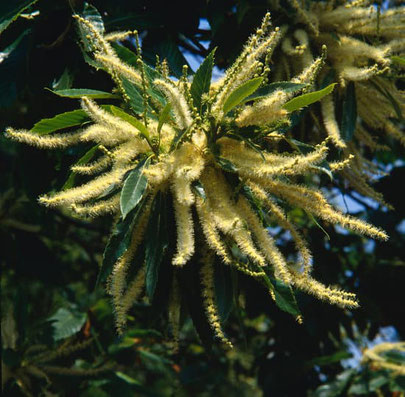Characteristics of the Sweet chestnut:
The Sweet chestnut or Spanish chestnut (Castanea sativa) is a deciduous tree from the beech family (Fagaceae).
The tree is tall, erect, with a wide, spreading crown. The root system has a strong central root and strong skeletal roots. The life cycle of a tree is up to 500 years. Depending on the variety, the sweet chestnut reaches a height of 10-40 m.
Planting the Sweet chestnut:
To plant a chestnut tree, choose a sunny and wide-open spot.
Before planting a chestnut, keep in mind that it does best in slightly acidic to neutral soil (pH 5.5-7.0), and liming is necessary in more acidic soil. The soil should preferably be fertile, rich in organic matter and well drained. Heavy and soggy soils are not suitable. This saturates the pores of the soil with water and deprives them of oxygen, exacerbating problems like root rot.

The trees are planted in spring or late autumn/winter. We recommend planting grafted chestnuts, as they start fruiting earlier (in the 2nd to 3rd year) and provide guaranteed quality.
With an intensive planting scheme (distance 4 - 8 m), 17-50 trees per hectare are required. With extensive planting, it is also possible to choose wide planting distances of 9 - 12 m.
The chestnut flowers from June to July and the fruit can be harvested from late September to early November. Good pollination is very important for high yields. In the case of the chestnut, this is done by insects. Chestnut culture requires cross-pollination with another suitable variety. It is therefore advisable to work with two varieties for larger plantations; self-fertile varieties can be used for smaller plantations or single trees.
Yield:
Yields can vary greatly between 1000-7000 kg/ha depending on the type of cultivation. Harvesting is done manually or with special machines.
New hybrid varieties are developed based on the four major families of European, Chinese, Japanese and American chestnuts.
Requirement:
Chestnuts have many uses. It is used in the culinary, cosmetic industry, in folk medicine and for obtaining excellent wood. It also finds interesting applications in the wine and leather industries.


Walnuts Bulgaria
Semerdzhievo / Smilekin, Selskostopanski dvor
GPS Koordinaten: 43°46'32.05"N , 26° 9'44.51"E oder 43.775587, 26.162301
Tel: ++359 (0) 87 9119888 (Deutsch/English) ++359 (0) 88 7379778 (Български, English)
E-Mail: info@walnuts-bulgaria.com
Visit us on www.facebook.com



